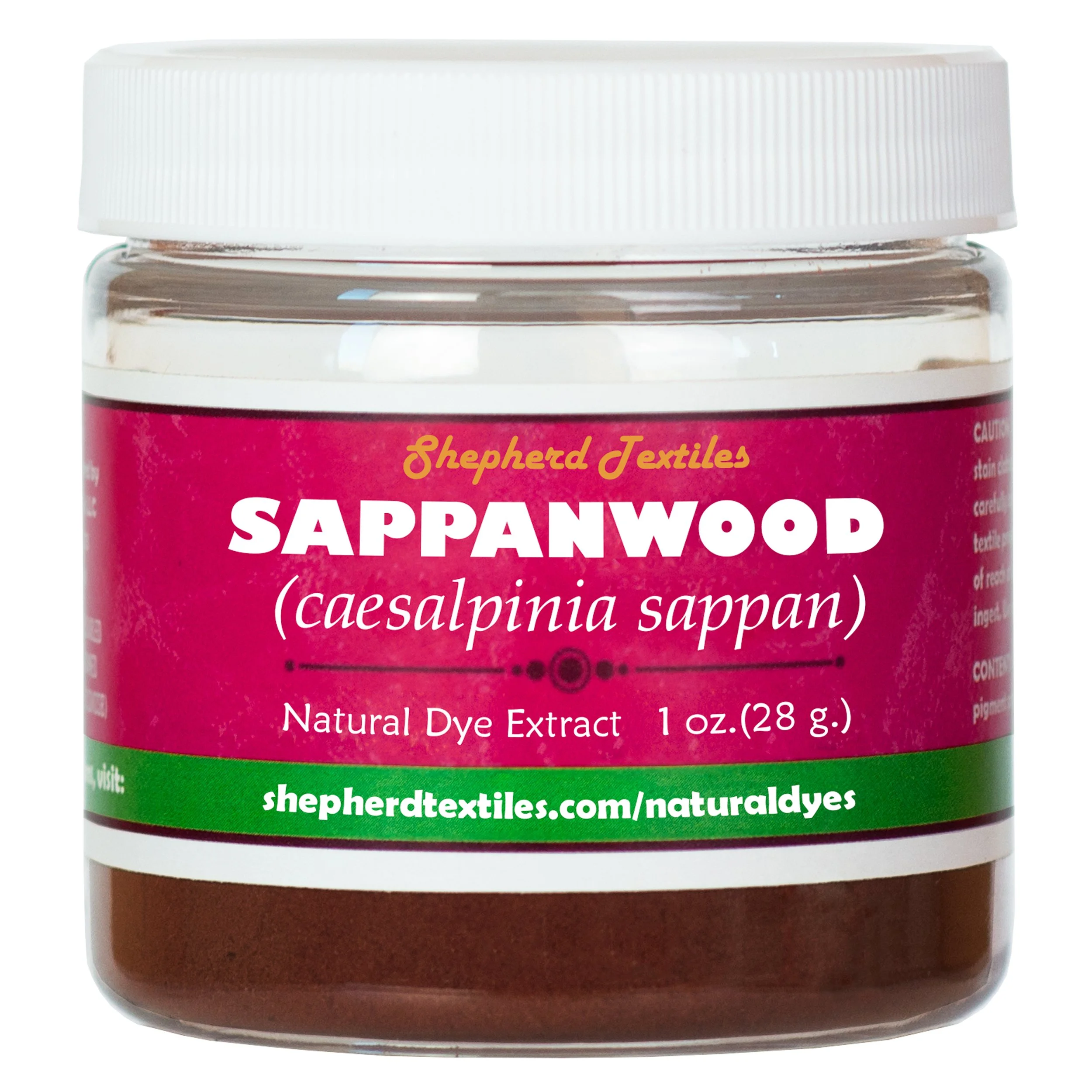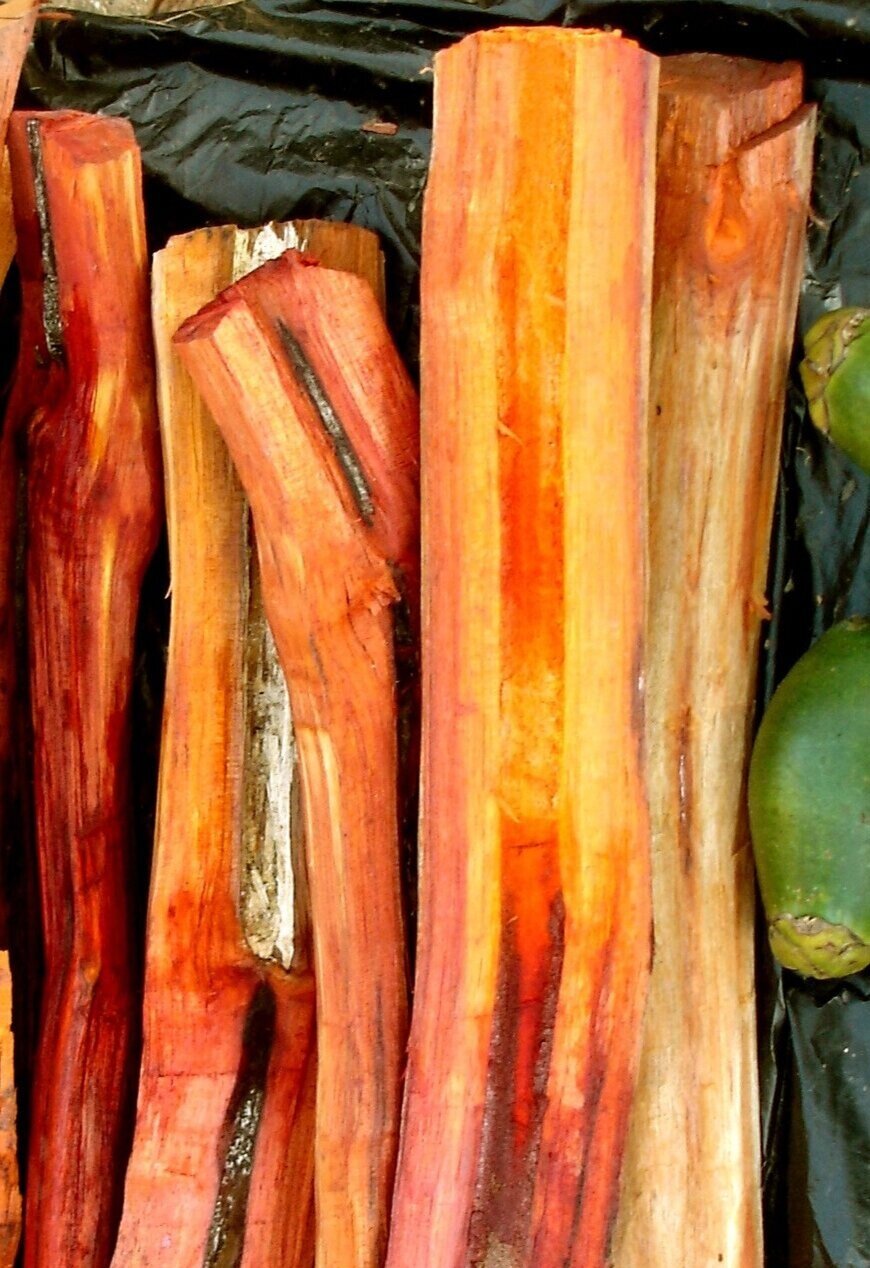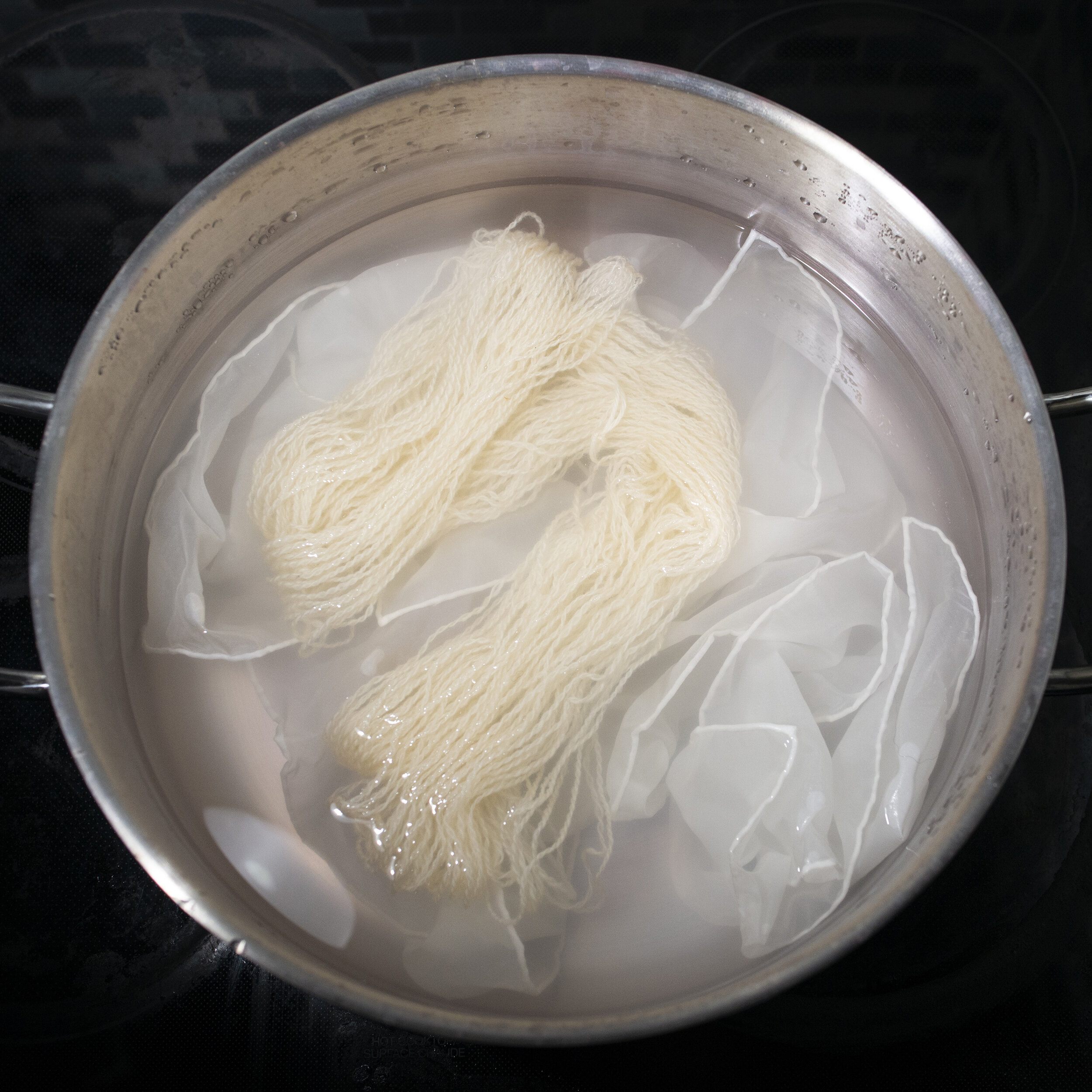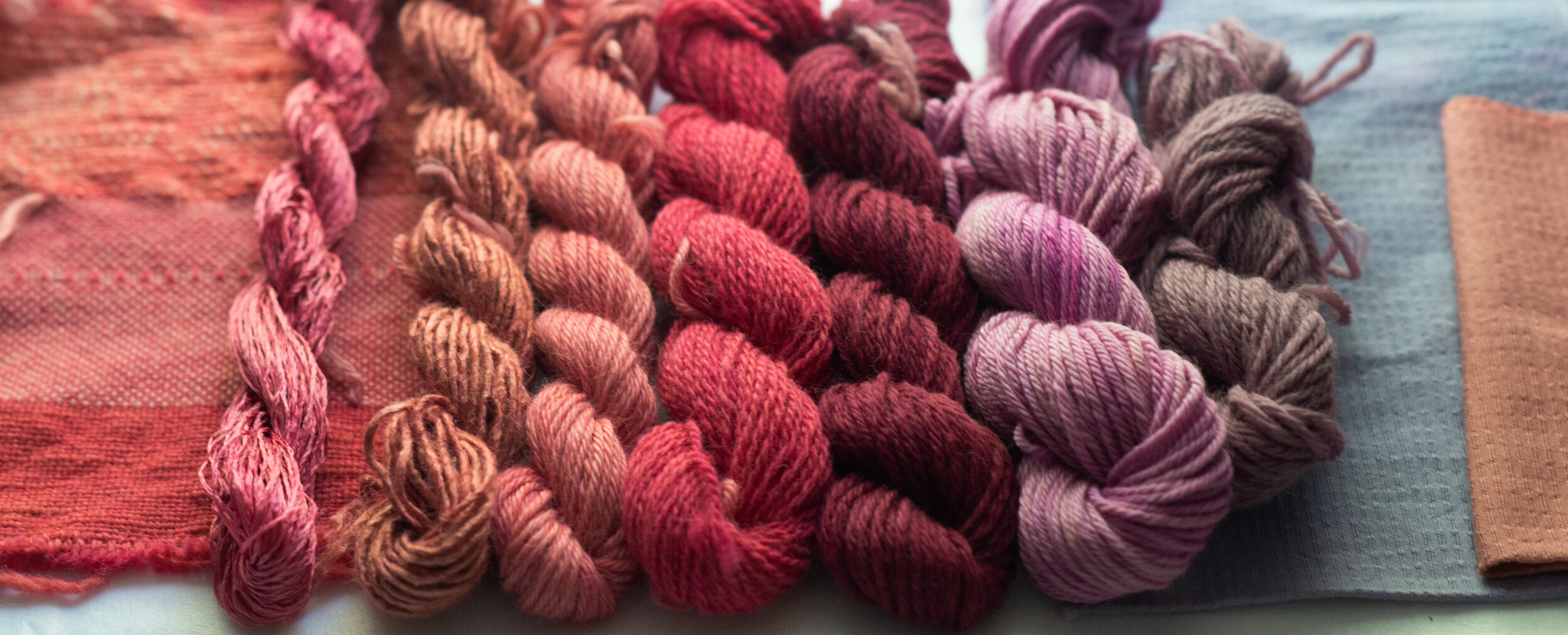
Sappanwood Extract
A Guide to Sappanwood Extract
Shepherd Textiles Sappanwood Extract is made from the heartwood of caesalpinia sappan, the Sappanwood or Eastern Brazilwood tree. Sappanwood contains a versatile red dyestuff called brazilin that will produce a range of beautiful hues depending on the mordant and the PH of the dyebath. It gives yummy cherry reds on alum-mordanted fibers and deep mulberry wine colors on fibers mordanted with copper. Use at 5%-10% weight of fabric for medium to dark hues. Our Sappanwood Extract is a highly concentrated form of the heartwood that is made in India from sustainably managed tree populations. Product of India. Produced by a GOTS (Global Organic Textile Standard) certified manufacturer.
1. Background on Sappanwood
The heartwood of the sappanwood tree, caesalpinia sappan, contains a strong red-pink dyestuff called brazilin. Brazilin is also the primary dyestuff in a closely related tree, the brazilwood, which gave the country of Brazil its name. Brazilin gives very strong crimson and maroon reds, and the wood is seemingly inexhaustible: a single quantity can often make multiple dyebaths. Brazilwood became one of the most profitable exports from colonial Brazil, and it was logged so thoroughly that the South American population was decimated and the tree almost went extinct in its native range. Sappanwood contains the same dyestuff as brazilwood but it is endemic to south and southeast Asia, hence why it is sometimes called “Eastern Brazilwood.” Fortunately, sappanwood has been harvested more sustainably and the trees have healthy populations throughout Asia.
Sappanwood is distantly related to logwood and it has similar dyeing characteristics. It produces intense cherry reds on an alum mordant, but these have a reputation as being fugitive to light (they will fade it left in a window). On a copper mordant, however, it produces strong, light-fast mulberry purples. It is sensitive to PH, and adding soda ash will shift the color toward purple, or toward a pretty steel blue on cotton mordanted with copper. Because the color can be modified in so many ways, sappanwood gives a wealth of dyeing possibilities, and it is a rewarding natural dye to experiment with.
2. Safety Precautions
DO NOT INGEST. This extract was prepared for textile dyeing, and is not a food.
Avoid eye contact. If eye contact occurs, rinse with cool water.
Not for use as a cosmetic additive; do not apply directly to skin or hair.
Open carefully to avoid spilling or creating dust.
Sappanwood Extract can permanently dye clothing, countertops, rugs, utensils, or other property. Avoid contact with anything that is not meant to be dyed.
If a spill occurs, quickly wipe up with a paper towel or disposable rag.
Use only dye pots and utensils dedicated to dyeing. Do not use any pots, containers, spoons, tongs, thermometers, or other utensils that will be used for food preparation.
Copper powder is an irritant and may be harmful if ingested. Read your manufacturer’s safety sheet (MSDS) before using copper as a mordant. Always wear gloves, a mask, and eye protection when handling metal powders like copper. Work in a well-ventilated space.
Sappanwood Extract, and all dye baths and mordant liquors made while dyeing, should be kept out of reach of children and pets. Use only with adult supervision.
Shepherd Textiles, LLC is not liable for any misuse of this product or any unintended staining of your clothing, workspace, or other property. Use only as directed.
3. Recommended Supplies
Dye pot. Use a dye pot large enough to hold all your fibers, with plenty of room for them to move around and for the liquid to circulate freely. The best choice for madder is a large stock pot with a non-stick surface. Madder can stain stainless steel pots. If that happens, the pink stains can usually be scrubbed out with a scouring pad.
Metal tongs. A pair of tongs is useful for stirring and taking fabric out. Use tongs dedicated to dyeing, and not for food preparation.
Rubber gloves. Wear rubber gloves while handling extract powder and while handling mordanted/dyed fiber before it is rinsed.
Candy thermometer. Madder creates the clearest reds when dyed at 180F. The best way to keep track of temperature is to use a cheap candy thermometer that clips to the side of the dye pot.
Scale. Use a scale to weigh out fiber, mordant, and extract powder.
Alum mordant. The alum usually used for mordanting is aluminum potassium sulfate, also known as potash alum. It is the same alum that you can find in a jar in the spice section at the grocery store.
PH strips. For adjusting the dye bath PH.
Disposable cup. For mixing the extract powder to a paste.
PH strips and a candy thermometer make it easier to control the dye bath.
4. Preparation: Mordanting
Sappanwood Extract requires a mordant to bond effectively to fibers. For best results, soak your fibers in water for a few hours before mordanting, so that the mordant will penetrate deeply and evenly. Make sure to weigh the fibers first, while they are still dry.
Mordant powders will dissolve quickly into hot tap water.
Heat fibers for an hour at 180F, then allow to cool.
For protein fibers (wool, silk, alpaca): Mordant at 12% WOF with alum or 2% WOF with copper*.
Weigh out the fibers you plan to dye (while they are dry). Multiply that weight by 0.12 to get the amount of alum you will need, or 0.02 to get the correct amount of copper.
Fill your dye pot with hot tap water, leaving enough room for the fiber.
Weigh out the correct amount of mordant and pour it into the dye pot. Mix with a spoon or metal tongs until it has dissolved.
Gently place your fibers into the mordanting solution.
Heat mordant bath to 180F and maintain heat for 1 hour. If you don’t have a candy thermometer, you will have to estimate the temperature. At 180F, steam vapor will be rising off the water but it will not be bubbling. If your mordant bath starts to bubble, turn down the heat.
Stir every 15 or 20 minutes to make sure fibers mordant evenly. If they do not, the dye will take better in some places than others.
After an hour, remove from heat and let cool to room temperature. Once cool, you can immediately proceed to rinsing, or you can leave the fibers to steep overnight in the mordant bath. This will improve results, especially when dyeing thick or tightly woven fabrics.
Remove cooled fibers. Wearing rubber gloves, gently squeeze excess mordant solution back into the pot. Rinse well in lukewarm water. The fiber does not need to be washed with detergent, but any excess mordant should be rinsed out. Set aside until ready to dye. Keep out of reach of children and pets.
Dispose of mordant solution according to local guidelines.
For cellulose fibers (cotton, linen, etc.): Scour and pre-treat with a tannin before mordanting.
Cellulose fibers are more resistant to mordanting than protein fibers, and may need to be pre-treated with a tannin so they will absorb the mordant more effectively. In our experience, success dyeing cellulose fibers also depends very much on the quality of fiber used. Handspun, handloom, and organic cotton and linen tend to take natural dyes very well, and it may be possible to skip the tannin step and still get good results. However, commercial cotton tends to be more resistant to natural dyes, possibly because of industrial finishing, and will often need to be tanned.
Scour cellulose fibers well. Traditionally this is done in a highly alkaline soda ash solution, but standard household detergents like Tide© are equally alkaline (PH 11), so we prefer to just toss the fiber in the washing machine on an high-temperature cycle with plenty of detergent.
[OPTIONAL] Apply a clear or light-colored tannin to the scoured fabric. Some good choices are Gallnut Extract, Tara, Sumac, or Myrobalan. To use, fill your dye pot with hot water, dissolve 2-5% WOF of your chosen tannin in the dye bath (check vendor’s instructions—each will need a slightly different WOF) and simmer for an hour. Be very careful to keep the fiber moving around: some tannins have insoluble particles that love to get stuck in fabric, and they can cause splotches later on in the dyeing process. After an hour, let cool, remove fibers and rinse well.
Mordant as described above.
CAUTION: Copper powder (copper sulfate pentahydrate) is an irritant and may be harmful if ingested. Please read your vendor’s safety sheet (MSDS) before using copper as a mordant. Wear gloves, a mask, and eye protection whenever handling metal powders. Keep mordants and mordant baths away from children and pets. If you prefer not to use copper in its powdered form, it is possible to get the same effect by making a copper solution from copper wires or coins; there are instructions available online.
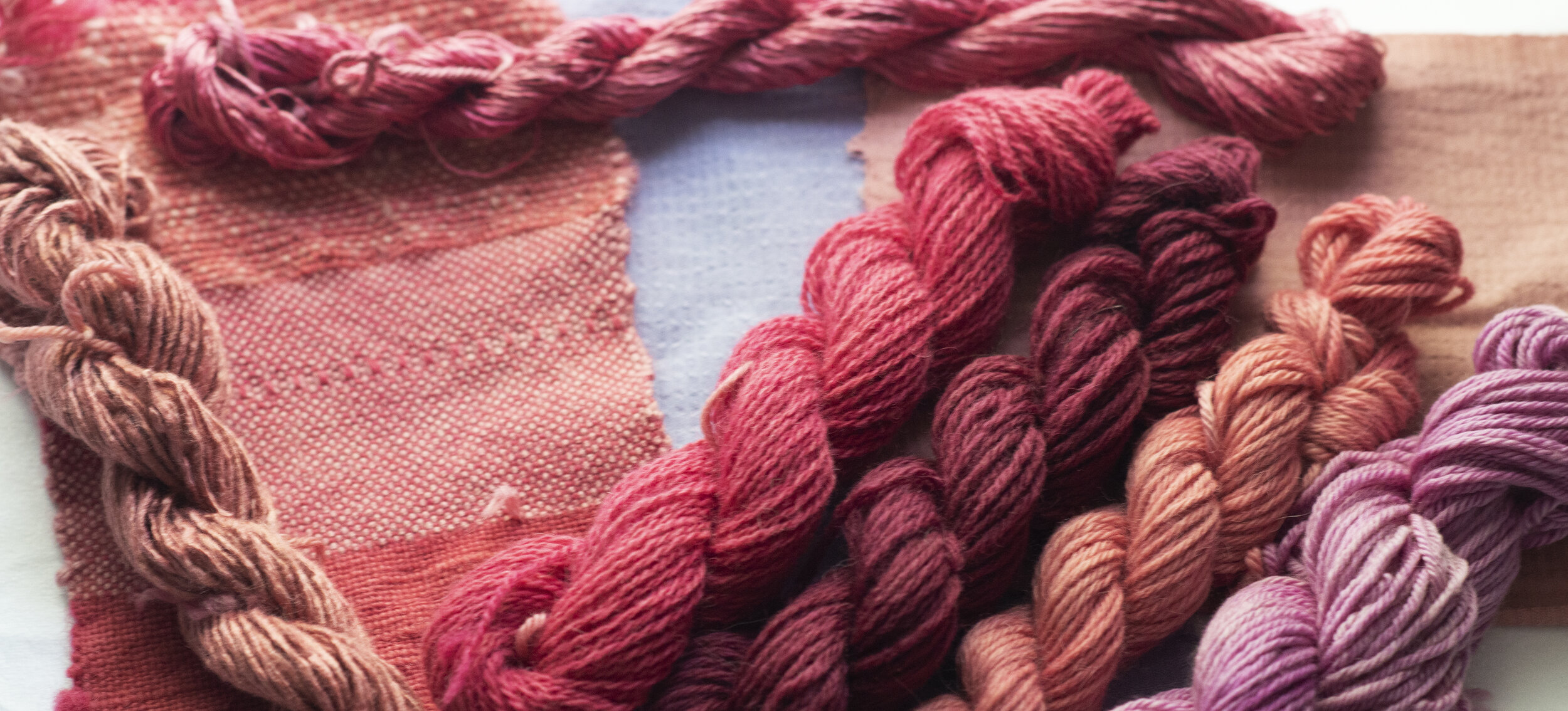
The Recipes.
5. Recipe - Candy Red
We do not usually describe colors as “yummy,” but it is hard not to use that word to describe the candy-colored reds that Sappanwood Extract gives on an alum mordant. Note that Sappanwood Extract contains insoluble wood particles that will not dissolve in water: instead the dyebath has to be brewed for a few hours first, almost like making a big pot of tea. Be sure to filter out any particles before adding the fiber.
Fill your dye pot with warm water, making sure there is enough room for the fabric to move around and for water to circulate freely.
Adjust the PH to neutral (7) with white vinegar or baking soda. If you don’t have PH strips, just leave it as is: most tap water is fairly close to neutral.
Weigh out 5% weight-of-fabric (WOF) Sappanwood Extract into a disposable cup (multiply the dry weight of the fabric by 0.05 to get the correct amount of extract).
You have two options for making a dyebath:
Add the powder directly to the dye bath and simmer at 170F for two or three hours, stirring occasionally. After a few hours, let the dyebath cool to room temperature, and strain it through cheesecloth or a large coffee filter to remove any particles of sappanwood.
Put the extract powder into an empty tea bag (or multiple empty tea bags, depending on how much you need). Tie it off and add to the dyebath. Simmer at 170F for two or three hours, stirring occasionally. After a few hours, remove the tea bag and dispose.
Add fibers pre-mordanted with alum to the dyebath. For best results, make sure they are thoroughly wetted.
Raise the temperature to 170F and maintain for 1.5-2 hours, stirring every 20 minutes or so to make sure everything dyes evenly.
After 1.5 to 2 hours, remove pot from heat and allow to cool to room temperature.
Remove the fibers and rinse briefly in lukewarm water to remove any undissolved particles of dye. You can either proceed immediately to rinsing with detergent, or hang the fabric up to dry first to help the color set. Make sure to hang it up somewhere where dripping dye will cause no damage.
For final rinsing, we recommend using a PH-neutral detergent sold for textile artists, since they are designed to wash out loose dye. Follow the manufacturer’s directions for best results. Be careful using commercial laundry detergents: most are extremely alkaline, and may shift the color of the fabric. CAUTION: Sappanwood will bleed if not thoroughly rinsed out after dyeing.
Hang up to dry.
NOTE: Results will vary depending on the fiber type and how thoroughly it is mordanted with alum. Alpaca, superwash wool, and cotton tend to yield slightly more pale reds while wool, silk, and linen will produce deep reds more easily.
6. Recipe - Mulberry Wine
The recipe for getting “Mulberry Wine” is the same as for “Candy Red,” the only difference being that it uses fibers mordanted in copper rather than in alum. It gives a deep, rich mulberry color that will be more color-fast and light-fast than the red produced with an alum mordant.
Follow the recipe for “Candy Red” described in Part 5. However, add fibers pre-mordanted with 2% weight-of-fabric (WOF) copper, instead of fibers mordanted with alum.
After simmering for 1.5 to 2 hours, remove the fibers and rinse briefly in lukewarm water. You can either proceed immediately to rinsing with detergent, or hang the fabric up to dry first to help the color set. Make sure to hang it up somewhere where dripping dye will cause no damage.
For final rinsing, we recommend using a PH-neutral detergent sold for textile artists, since they are designed to wash out loose dye. Follow the manufacturer’s directions for best results. Be careful using commercial laundry detergents: most are extremely alkaline, and may shift the color of the fabric. CAUTION: Sappanwood will bleed if not thoroughly rinsed out after dyeing.
Hang up to dry.
7. Recipe - Steel Blue
Sappanwood will shift from red to purple in an alkaline dye bath. We do not recommend using this recipe on wool, as alkaline modifiers tend to make wool look pale and washed-out, and can damage its softness or “hand.” However, on copper-mordanted cotton, adding soda ash will give a pretty steel blue.
Follow the recipe for “Candy Red” described in Part 5. However, do not adjust the starting PH of the dyebath to neutral (7), since you will adjust it later with soda ash.
After brewing the dyebath, but before adding fiber, adjust the PH to 10 with soda ash. It is best to use PH strips for this, but if you don’t have any, add soda ash 1/2 a teaspoon at a time until the dyebath is dark purple. It will probably not take more than a teaspoon or two.
Add cotton mordanted with copper, and simmer for 1.5 hours at 180F.
Remove the fibers and rinse briefly in lukewarm water. Hang up to dry to help the color set. Make sure to hang up in a place where dripping dye won’t cause any damage.
When ready for the final rinse, rinse thoroughly with detergent as described in the recipe for “Candy Red.”
Hang up to dry.
*All text and images are copyright of Shepherd Textiles, LLC. Do not reproduce without permission and attribution.


